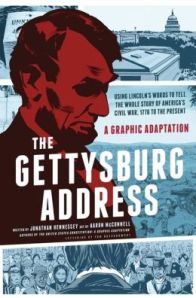 Jonathan Hennessy and Aaron McConnell, The Gettysburg Address: A Graphic Adaptation (New York: William Morrow, 2013). $15.99, 224 pages.
Jonathan Hennessy and Aaron McConnell, The Gettysburg Address: A Graphic Adaptation (New York: William Morrow, 2013). $15.99, 224 pages.
At the outset, I should confess that I am not a reader of graphic novels. Indeed, The Gettysburg Address by Jonathan Hennessy (writer) and Aaron McConnell (artist) is the first one I have ever read from cover to cover, let alone with any enjoyment. I am, however, a lover of all things Lincoln, so in the sesquicentennial of his address, I resolved to purchase and read this graphic novel.
A graphic novel has to be reviewed in two parts: the substance of the writing and the form of the art. Let me start with the latter. Aaron McConnell has done a superb job illustrating the Jonathan Hennessy’s text. As an avid reader of text-only books, I worried that the graphics might get in the way of the text. In fact, they enhanced it. One example, on page 22: Early in the Civil War, Abraham Lincoln appointed general after general to lead the Union armies, each of whom he replaced when they didn’t do an adequate job. A text-only approach would spend hundreds of words to explain what McConnell shows in a single picture: four Union generals marching through a revolving door. Brilliant! My only complaint is that in several frames, where Hennessy quotes historical documents, he uses a cursive type script that was hard to read, at least for me. (See Robert E. Lee’s letter on page 26, for example.)
That brings me to the substance of Jonathan Hennessy’s writing. What Hennessy does is use the words of the Gettysburg Address to organize a historical brief of the historical forces that led to the Civil War, reached critical mass at Gettysburg, and then were channeled into Reconstruction and the Civil Rights Movement. On the whole, this organization works well, resulting in a coherent narrative.
There is much to commend in this narrative. However, I repeatedly choked on Hennessy’s simplistic distinction between Lincolnian “big government” and Southern “small government,” with its concomitant praise of centralized federal power and its critique of states’ rights. There are fewer “big” governments than state governments that legalized slavery, and fewer “small” governments than Lincoln’s nuanced attention to the limits of his constitutional powers in the Emancipation Proclamation. Moreover, through much of the nation’s history, the federal government—especially the Supreme Court in its Dred Scott and Plessy v. Ferguson decisions—was the engine of oppression, not the liberator from it. Meanwhile, Northern states took the lead in emancipating slaves.
The question of the Civil War, then, is not whether government should be big or small according to some abstract metric, but which government—Federal or state? Executive, legislative, or judicial?—should exercise its powers under the Constitution, and how. The Civil War forever settled the nature of the American union, but it didn’t repeal the 10th Amendment. Within their respective frames, the federal and state governments have enumerated constitutional powers that make them “big,” as well as constitutional limits that keep them “small.”
Despite my philosophical reservations about Hennessy’s narrative, I read, enjoyed, and recommend this graphic novel. Prior to The Gettysburg Address, Hennessy and McConnell produced The United States Constitution: A Graphic Adaptation. Given my positive experience with this graphic novel, I look forward to reading that one too.
P.S. If you found my review helpful, please vote “Yes” on my Amazon.com review page.


One thought on “Review of ‘The Gettysburg Address: A Graphic Adaptation’ by Hennessy and McConnell”